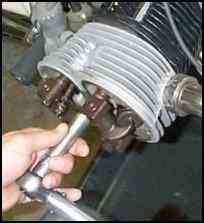To do this, take a 14 mm torque wrench and set it at 28 foot/pounds. Check each head bolt by tightening it to 28 foot/pounds. You should do this to the four head bolts in an "X" pattern. If you have an R69 or a R69S, there will be six head bolts. If the head bolts do move at 28 foot/pounds of force, usually you will find that the valve lash (clearance between the valve stem and the end of the rocker arm) will close tight. That's why you must use a feeler gauge to re-adjust them.


